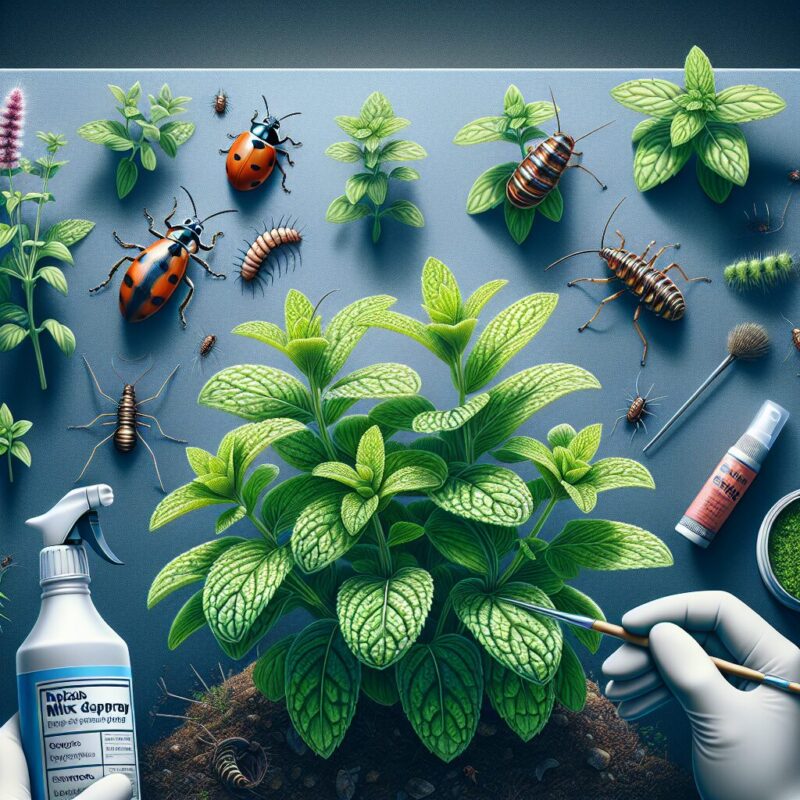Mint plants are widely appreciated for their refreshing aroma and versatility in culinary, medicinal, and aesthetic applications. However, keeping these vibrant green leaves intact can be a challenge when pest infestations, particularly from bugs, start to take a toll. Bugs, such as aphids, spider mites, and flea beetles, can wreak havoc on mint plants, feeding on their foliage and causing damage that compromises their health and overall growth. Understanding how to prevent and control these bugs from devouring your beloved mint plant is crucial for maintaining a thriving garden or indoor herb collection.
Before we delve into the solutions for protecting your mint plant from bug munchers, let’s explore the specific impacts these insects can have and the unique features that make mint plants susceptible to their invasion. Infestations of bugs can significantly weaken mint plants, leading to stunted growth, yellowing leaves, and even plant death if left unaddressed. Due to its appealing scent and tasty flavor, mint naturally attracts bugs. Additionally, the mint plant’s luscious foliage and succulent stems provide a cozy home for various insects. Furthermore, the rapid growth and spreading habit of mint plants make it easy for bugs to move from one plant to another, perpetuating the infestation. Now, let’s uncover some effective strategies to put a stop to these pesky critters, ensuring your mint plants flourish bug-free.
Key Takeaways
1. Regularly inspect the mint plant for signs of bug infestation, such as chewed leaves or holes, and take immediate action to prevent further damage.
2. Use a variety of natural methods to deter bugs from eating mint, such as companion planting with marigolds or garlic, or using homemade insecticidal sprays made from ingredients like neem oil or soapy water.
3. Introduce beneficial insects like ladybugs or lacewings to the garden, as they can help control populations of bugs that eat mint.
4. Keep the mint plant healthy and stress-free by providing adequate water, proper sunlight, and regular pruning, as strong and healthy plants are less likely to be attacked by pests.
5. Avoid using chemical pesticides on the mint plant, as they can harm beneficial insects and contaminate the plant. Instead, opt for more natural pest control methods to protect both the mint plant and the environment.
How Can You Prevent Bugs from Destroying Your Mint Plants?
Identifying the Common Bugs Affecting Mint Plants
Mint plants are highly susceptible to attacks from various insects and pests. It is crucial to identify the specific bugs that commonly target mint plants in order to effectively address the issue. The most common pests that feed on mint plants include:
- Aphids
- Spider mites
- Cutworms
- Whiteflies
- Earwigs
- Squash bugs
Implementing Natural Pest Control Methods
Instead of relying on harmful chemicals, adopting natural pest control methods is not only more environmentally friendly but also safer for your mint plants. Here are some effective natural ways to prevent bugs from eating your mint plants:
1. Introduce Beneficial Insects
Attracting natural predators to your garden is an excellent method to deter and control bug infestations. Some beneficial insects, such as ladybugs, lacewings, and predatory mites, feast on pests like aphids and spider mites. You can introduce these good bugs by planting companion plants that attract them or purchasing them from local garden centers.
2. Apply Homemade Insecticidal Soap
An organic insecticidal soap can be easily prepared at home by mixing liquid dish soap and water. Gently spraying this solution onto the affected mint plants will effectively eliminate soft-bodied pests such as aphids and whiteflies. Remember to thoroughly cover both sides of the leaves.
3. Use Neem Oil
Neem oil, derived from the seeds of the neem tree, has insecticidal properties and helps control a wide range of bugs without harming beneficial insects. Dilute the neem oil according to the instructions on the package and spray it on your mint plants, covering all areas affected by pests.
Practicing Preventative Measures
Prevention is key to ensuring the long-term health and protection of your mint plants. By practicing the following preventative measures, you can avoid bug infestations:
1. Regularly Inspect Your Mint Plants
Be vigilant and inspect your mint plants regularly, paying attention to the undersides of leaves where bugs often hide. Early detection allows for prompt action, preventing further damage.
2. Encourage Air Circulation
Proper air circulation is crucial in deterring bugs from infesting your mint plants. Overcrowding and dense foliage create an ideal environment for pests, so ensure that there is enough space between each plant to promote air circulation.
3. Maintain Soil Moisture Levels
Consistently monitor the moisture levels of the soil in which your mint plants are growing. Avoid overwatering, as it can attract bugs and promote the growth of diseases. Similarly, underwatering can stress the plants, making them more susceptible to pests.
4. Regularly Remove Weeds and Fallen Debris
Weeds and fallen debris act as hiding places for bugs, attracting them to your mint plants. Regularly remove any weeds or debris from the vicinity of your mint plants to discourage pests from taking up residence.
- Inspect your mint plants regularly, especially the undersides of leaves, for signs of bug infestation.
- Attract beneficial insects to your garden by planting companion plants.
- Prepare a homemade insecticidal soap by mixing liquid dish soap and water.
- Utilize neem oil to control a wide range of pests without harming beneficial insects.
- Ensure proper air circulation around your mint plants.
- Maintain appropriate soil moisture levels to prevent bug infestations.
- Regularly remove weeds and fallen debris from your mint plants’ surroundings.
Frequently Asked Questions
1. What are the most common bugs that eat mint plants?
The most common bugs that tend to feast on mint plants include aphids, spider mites, mint leaf beetles, and caterpillars.
2. How can I identify bug infestation on my mint plants?
Look out for signs like chewed leaves, discolored spots, sticky residue on the leaves, or visible bugs crawling on the plant. These are indications of a bug infestation.
3. Are there organic methods to control bug infestation on mint plants?
Absolutely! Organic methods include using insecticidal soap sprays, neem oil, or introducing beneficial insects like ladybugs or lacewings to control the bug population.
4. Can I prevent bugs from eating my mint plants without using chemicals?
Yes, you can! Growing mint plants near bug-repelling companions like marigolds, basil, or lavender can help deter bugs naturally. Regularly inspecting your plants and removing any affected leaves can also prevent infestations.
5. Is it safe to use chemical pesticides on mint plants?
While chemical pesticides can effectively control bugs, it is recommended to avoid using them on edible plants like mint, as they can leave toxic residues. Opt for organic methods to ensure the safety of your harvest.
6. How can I attract beneficial insects to my mint plants?
Planting flowers like daisies, yarrow, or sunflowers around your mint plants can attract beneficial insects that prey on pests. Creating a diverse garden ecosystem will naturally support the presence of these helpful insects.
7. Can companion planting protect mint plants from bug damage?
Yes! Certain plants like garlic, chives, or catnip repel bugs that commonly affect mint plants. By incorporating these companion plants, you can create a natural defense around your mint.
8. Are there any cultural practices that can protect mint plants from bugs?
Regularly pruning mint plants and removing the lower leaves can increase airflow and reduce the risk of infestations. Additionally, providing adequate sunlight, watering properly, and avoiding over-fertilization can strengthen the plants and make them less susceptible to bugs.
9. Can I grow mint plants indoors to avoid bug problems?
Absolutely! Growing mint indoors in pots or containers provides better control over pests. Just ensure the plants receive sufficient sunlight and proper ventilation for their optimal growth.
10. How frequently should I inspect my mint plants for bug damage?
It is advisable to inspect your mint plants at least once a week for any signs of bug damage. Early detection can prevent severe infestations and help you take immediate measures to protect your plants.
Final Thoughts
Keeping your mint plants safe from pesky bugs can be a challenging but rewarding task. By following organic methods, attracting beneficial insects, and practicing good cultural habits, you can create a thriving garden environment that minimizes bug damage. Remember to stay vigilant, inspect your plants regularly, and take prompt action when necessary. With proper care, your mint plants will flourish, providing you with a fresh supply of mint for culinary delights and refreshing beverages.
In conclusion, protecting mint plants from bug infestation requires a proactive approach. Embracing natural methods not only ensures the health and safety of your plants but also benefits the overall ecosystem of your garden. By nurturing your mint plants while being mindful of bug control, you can enjoy an abundant harvest while savoring the delightful aroma and taste of homegrown mint.

